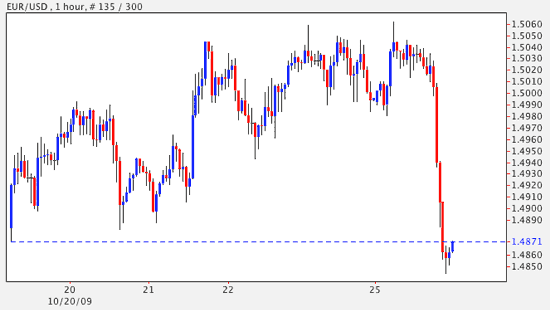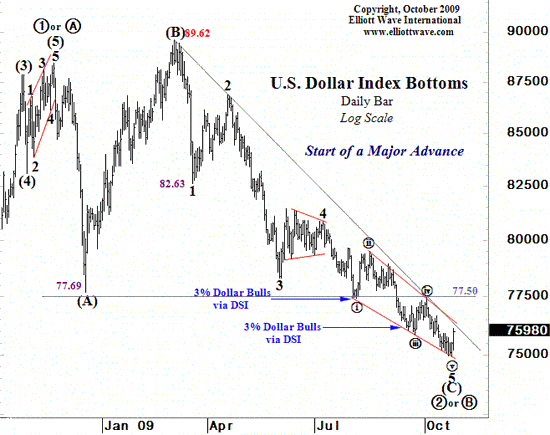Breaking above $1.50 to the Euro was huge – yesterday the Euro fell hard below that level. See chart. Dollar down means almost all other currencies up – and lots of nations have been trying to stop that appreciation by intervening in forex markets to drive their currencies down. China changed policy a year ago July of letting the Yuan have a controlled float, sparking the commodities sell-off last year, and since then has taken advantage of the dropping USD by dropping with it, to the consternation of the surrounding Asian Tigers. It made their currencies relatively uncompetitive with China. They have been active intervenors to support he USD but to minor effect. Intervention to get the Euro down below $1.50 is quite a different matter of scale and impact.

The sharpness of the Dollar rise in the Dollar Index (DX) and fall against the Euro signals a likely change of trend to up. In a few trading days the DX has gone from 74.9 to over 76 – a huge move. It is very close to breaking a recent wedge trendline, which would confirm a bifurcation has occurred. See chart courtesy tonight’s STU. The STU is watching a break of DX77.5 to confirm the this change of trend os over a major degree. If it occurs, it signals a strong rise in the Dollar to above DX90. A reversal back to DX75.20 means this is a false break, not the bottom yet.

I have been writing that the markets are running inverse to the Dollar. This not at all surprising or profound to the ewave universe, but is against conventional wisdom which still surfs along the surface of things to make market calls. What it means is crystal clear:
A bottom in the Dollar signals a top in everything else.
Major bottoms or tops are often not coincident but sloppy, so it does not necessitate all markets turning together. Indeed, that would be unusual; but we are in unusual times, once-in-a-lifetime times of the deflationary depression that follows a huge credit bubble. We had them in 1929, 1873 and 1837, and although many have read about the Great Crash in 1929, few remain who really experienced it. The rules-of-thimb in the investing world have really grown out of the experiences post WWII, indeed post the 1949 end to the trading range of the Great Depression and the beginnings of great bull runs of 1950-66 and 1982-00 that mark the American Century.
We have been in a rare Currency Market since 2002, a market driven primarily by the Greenspan Indian Summer of reflation to stave off the deflation of Kondratieff WInter (which he explicitly acknowledged in a paean to Kondratieff). The reflation policy of the Greenspan Put has been continued by “Helicopter” Ben Bernanke. Hence, we should see almost all markets turn on the Dollar.
This means lighten up on gold, get out of oil (quickly, it is a volatile market), back off those Carry Trade perennials like the AUD and Loonie, and get out of equities. Bonds may be on a spike to higher rates, which is bearish; more on that as it unfolds. If we are truly in a return of risk aversion, after the spike Treasuries should rise (and rates fall) as money rushes there in the vacuum of a fall in everything else.
A Dollar Bottom also signifies an over-turning of the assumptions that have fueled the Obama Hope Rally, and a return to risk aversion after a summer of hope. Watch the DX closely. Until it bifurcates above the wedge trendline, it could be a false break. The sharpness of today’s move suggests a short squeeze is on, against those who have been betting on the Dollar going excessively lower.
In equities watch for a break of the trendline from Mar9 through Jul8, the 0-B line. A break of that confirms the bifurcation of equities. Right now it is running between Sp1050-55, and Dow9500-9550.
- Bulenox: Get 45% to 91% OFF ... Use Discount Code: UNO
- Risk Our Money Not Yours | Get 50% to 90% OFF ... Use Discount Code: MMBVBKSM
Disclaimer: This page contains affiliate links. If you choose to make a purchase after clicking a link, we may receive a commission at no additional cost to you. Thank you for your support!



Leave a Reply